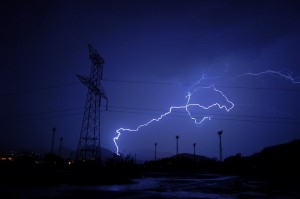 Print a Sign-In Sheet | Spanish Version
Print a Sign-In Sheet | Spanish Version
Thunderstorms that produce lightning are most likely to develop on hot humid days. These storms can be very dangerous, especially if a person is outdoors. If lightning is seen, protective action should be taken immediately.
Five ways lightning can severely injure or kill:
- Direct strike – Usually results in cardiac arrest and/or stoppage of breathing.
- Side flash – Occurs when a person is another route for the current to reach the ground; death can result if the current passes through the heart or head.
- Step voltage – Spreads out through the ground from a struck pole or tree.
- Conducted current – From poorly grounded electric power pole, through the wiring system; can range from mild tingling shock to a massive current.
- Secondary effects – Can be from fires, fallen trees, etc., that occur as the result of a lightning strike.
Protection during storms:
- Seek shelter inside a building, car, or truck and close all windows and doors.
- Turn off all electrical appliances and unplug them if possible.
If stranded outside:
- Stay away from tall isolated objects, such as trees, poles, clotheslines, etc.
- Avoid metal objects, such as pipes, chain link fences, electric fences, etc.
- Drop objects that may conduct electricity, such as pitch forks, rakes, hoes, etc.
- Standing under a group of trees that are shorter than others in the area is better than standing out in the open.
- Seek low ground, such as ditches or gullies.
- Make your body low to the ground but do not lie flat. Curl into a fetal position or get on your knees and lay your body forward.
- If you are in a group of people, spread out.
- Stay clear of downed power lines and report them to police immediately.
KEMI does not assume liability for the content of information contained herein. Safety and health remain your responsibility. This information is to be used for informational purposes only and not intended to be exhaustive or a substitute for proper training, supervision, or manufacturers’ instructions/recommendations. KEMI, by publication of this information, does not assume liability for damage or injury arising from reliance upon it. Compliance with this information is not a guarantee or warranty that you will be in conformity with any laws or regulations nor does it ensure the absolute safety of any person, place, or object, including, but not limited to, you, your occupation, employees, customers, or place of business.

